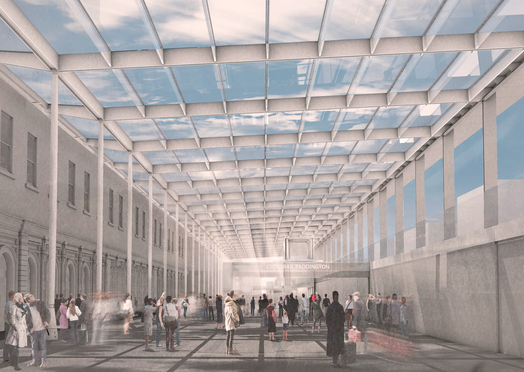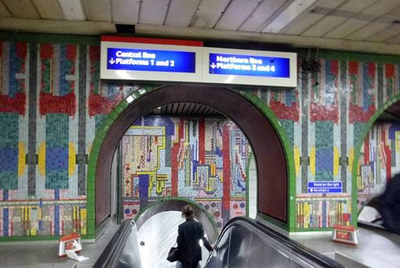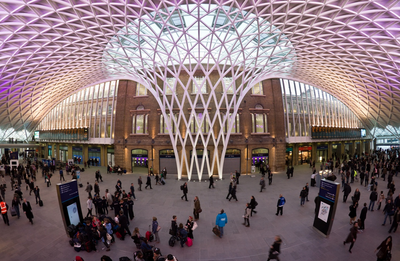| The Royal Academy (RA) event ‘Humanising Infrastructure: Connecting to Culture in Major Projects’ raised important questions about the role of culture in the design and architecture of new places. Culture often translates in people’s minds as public art, which is often installed late in the day when architectural plans are fixed. Writer and critic Peter Dormer once said, 'good modern architecture needs no art, and conversely bad modern architecture cannot be rescued by art.' . Whilst this may hold some truth, I would argue that this is only the case if we view art in a very traditionalist sense... |
A painting or sculpture bolted onto a building in a superficial kind of way is conceivably ‘lipstick on the face of a gorilla’, to quote Norman Foster.
However, art is in many ways synonymous with culture. It has always concerned itself with the way in which people behave and express themselves - either through capturing realistic human forms and interactions, using expression to create an emotive response, or physically involving the viewer within the work to create environments in which culture can be played out in real-time.
As art continues to move with the times it is apt that architecture should also function well within the digital age and offer immersive experiences, encouraging visitors to play a role within the space inside and outside of the physical infrastructure. The role of art within the architectural realm is partly to encourage the creation of spaces which allow for expression and enjoyment. It is precisely when we start to consider aesthetics and the emotive response to our surroundings that we are reminded of the truth; as well as shaping the environment, architecture and industrial design can shape how people feel. As the recent New London Architecture (NLA) conference on ‘London’s Future Cultural Offer’ suggested, It would be a mistake to operate as though buildings are isolated from the local area and the people that use them. [1]
The key then, is to perceive of space as a form of cultural campus. As well as thinking creatively and artistically about building forms, architects need to ensure that they collaborate with artists and incorporate public, accessible and inclusive spaces at the planning stage. Proactivity over reactivity will embed culture within the building DNA, encouraging places for expression. Art may not be able to rescue bad modern architecture but it can go some way to avoiding it.
It is promising that CrossRail, the biggest construction project in Europe, has acknowledged the need for art. With an additional 990,000 estimated commuters entering the city on completion, imaginative use of space is key to ensuring that the holistic traveller experience is a pleasant one. The commissioned culture line involving 8 stations, galleries and artists should enrich this cultural experience.[2]
When we talk about ‘Humanising Architecture’, we are simply calling for architecture to operate on a more human level, to positively impact human behaviour and modes of expression. We are seeking places which allow for greater interaction, inspiration, inclusion and congregation; places which bear the social fabric of the community in mind. We want to be challenged to belong, for the walls to whisper ‘this is for you’, for landscaping to demand to be explored, and for places to truly feel like they are for the people.
Author: Sarah Moor
However, art is in many ways synonymous with culture. It has always concerned itself with the way in which people behave and express themselves - either through capturing realistic human forms and interactions, using expression to create an emotive response, or physically involving the viewer within the work to create environments in which culture can be played out in real-time.
As art continues to move with the times it is apt that architecture should also function well within the digital age and offer immersive experiences, encouraging visitors to play a role within the space inside and outside of the physical infrastructure. The role of art within the architectural realm is partly to encourage the creation of spaces which allow for expression and enjoyment. It is precisely when we start to consider aesthetics and the emotive response to our surroundings that we are reminded of the truth; as well as shaping the environment, architecture and industrial design can shape how people feel. As the recent New London Architecture (NLA) conference on ‘London’s Future Cultural Offer’ suggested, It would be a mistake to operate as though buildings are isolated from the local area and the people that use them. [1]
The key then, is to perceive of space as a form of cultural campus. As well as thinking creatively and artistically about building forms, architects need to ensure that they collaborate with artists and incorporate public, accessible and inclusive spaces at the planning stage. Proactivity over reactivity will embed culture within the building DNA, encouraging places for expression. Art may not be able to rescue bad modern architecture but it can go some way to avoiding it.
It is promising that CrossRail, the biggest construction project in Europe, has acknowledged the need for art. With an additional 990,000 estimated commuters entering the city on completion, imaginative use of space is key to ensuring that the holistic traveller experience is a pleasant one. The commissioned culture line involving 8 stations, galleries and artists should enrich this cultural experience.[2]
When we talk about ‘Humanising Architecture’, we are simply calling for architecture to operate on a more human level, to positively impact human behaviour and modes of expression. We are seeking places which allow for greater interaction, inspiration, inclusion and congregation; places which bear the social fabric of the community in mind. We want to be challenged to belong, for the walls to whisper ‘this is for you’, for landscaping to demand to be explored, and for places to truly feel like they are for the people.
Author: Sarah Moor
[1] The decision to address the exterior of the Hayward Gallery during its upcoming renovation is exemplary of the perceived importance of user friendly buildings which are beautiful, stimulating and fit for purpose both inside and out.
[2] The outrage at the recent dismantling of Paolozzi’s murals at Tottenham Court Road Underground Station proves just how valuable art and culture is perceived to be, reinforcing its contribution to place making.







 RSS Feed
RSS Feed
